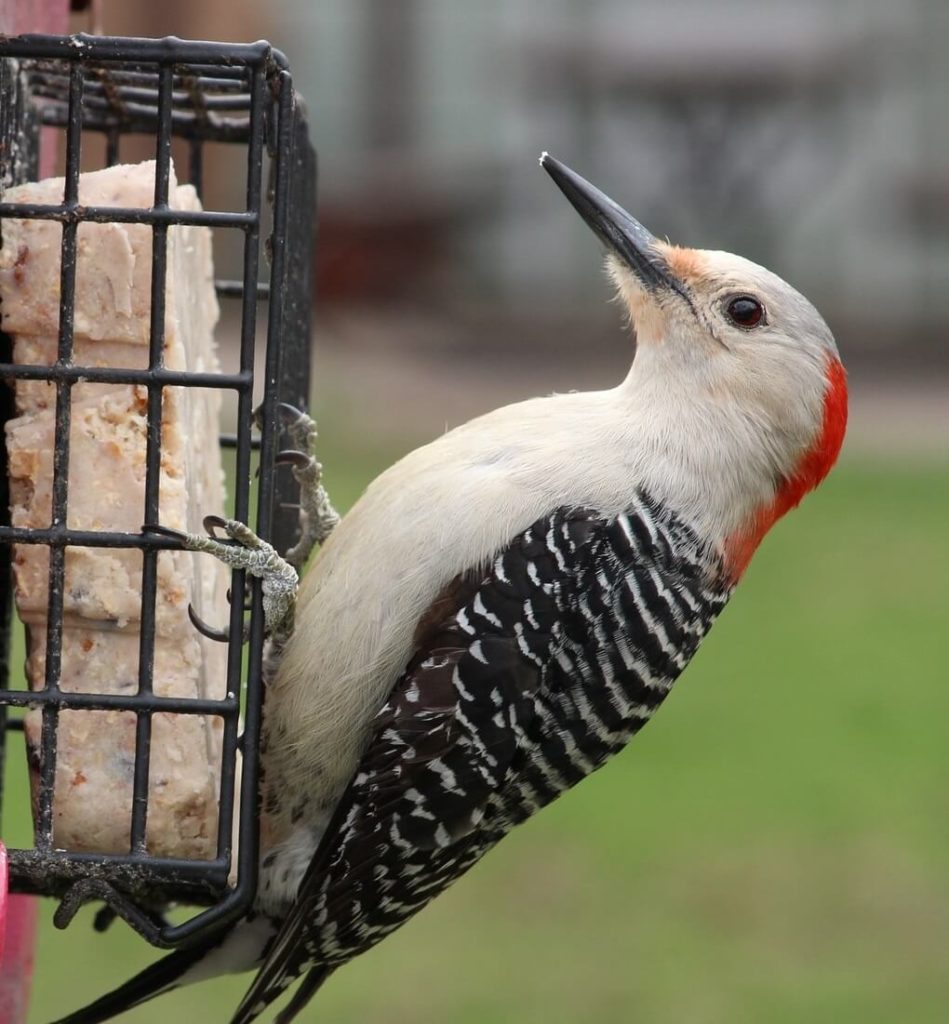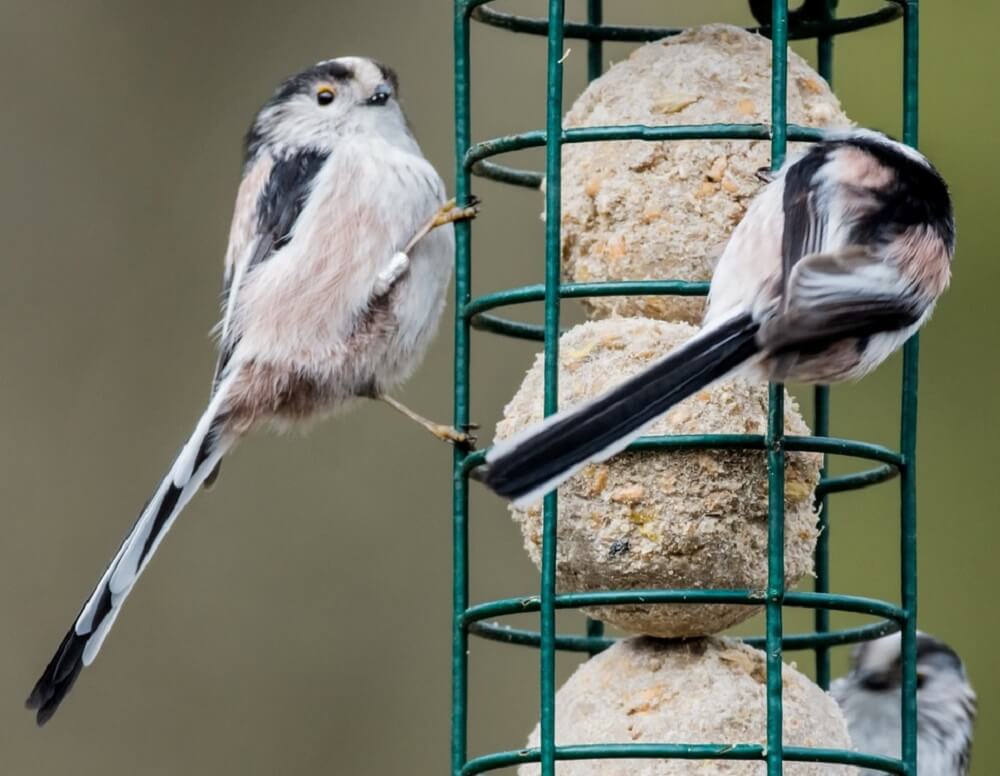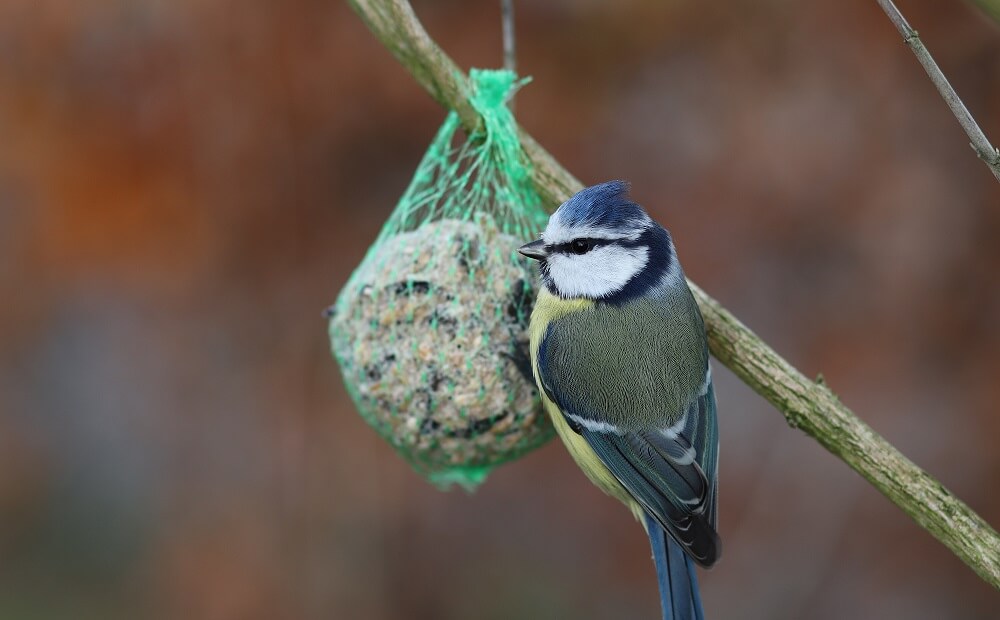Where To Place A Suet Feeder
Suet offers high-calorie food for especially active, busy birds. It comes in many forms and can be bolded into balls, sheets, crumbles, or other shapes.
Various bird feeders require specific shapes of suet and suet feeders may require specific commercial suet to be used inside.
What Is Suet?
Suet is the raw, hard fat that’s found around the loins and kidneys in beef and mutton. It is used in many traditional Brittish recipes.
Suet has a melting point of 45-50 degrees celsius and adds a dark, rich flavor to dishes. It coagulates at between 37 and 40 degrees celsius. Because it smokes at a high temperature, it is also used for deep frying.
Suet is high in calories and is a popular base ingredient in some bird feeders.
Substitute fats and oils are also used because suet isn’t as common in some kitchens.
You can use peanut butter, lard, and other fats as a suet substitute for suet bird feeders.
Where To Place Suet Bird Feeder
Suet can go rancid quickly in hot weather.
So, it’s important to keep suet feeders in areas that are shaded most of the day.
Hanging off a roof works well.
Plus,
It’s also important to hang suet feeders in areas that cat’s won’t be able to reach. Suet attracts cats.
Cats will kill the birds feeding and eat the suet.
Suet feeders should be placed 10-15 feet high. They should also be placed about 10 feed from tree branches large enough to support a cat.
Plus,
Suet feeders can be placed on a shepherd’s pole with a baffle to keep rodents away. This allows you to place the feeder in the best location.
And, the baffle protects the suet from some pests and the sun.
Don’t forget!
Be careful about where you place suet feeders in relationship to windows. Window deaths are very high for birds.
Either place suet feeders within 3 feet of a window or more than 30 feet. Close feeders are too near windows for birds to be flying at full speed and result in death.
Far feeders make it unlikely that birds will try to fly through the window.
Also- place suet feeders away from other bird feeders.
Yes. I know.
This is contrary to the advice everyone gives you. But, suet bird feed will attract many beautiful birds. Most of them are shy.
They don’t like to eat with other birds around.
So if you place your suet feeder by other bird feeders, you won’t see the variety of birds that you would otherwise.
- Put suet in shaded areas
- Place in areas safe from cats
- 10-15 feet high
- 10 feet away from tree branches
- Shepherds pole with a baffle
- Be aware of suet placement in relation to windows
Suet Is Good For Birds
Suet helps birds to keep their body temperature up during colder winter months. It is packed with calories and often combined with high protein ingredients.
Suet is easy for birds to digest.
What Kinds Of Birds Like Suet?
Many kinds of birds eat suet including small and large birds. In any area, there are several species of birds that will love a suet feeder.
Some of the birds that eat suet include:
- Woodpeckers
- Chickadees
- Tits
- Wrens
- Nuthatches
- Titmouse
- Robins
- Sparrows
- Orioles
- Grosbeak
- Cardinals
- Finches
- Bluebirds
- Mockingbirds
- Thrushes
There are many so called pest birds that love suet also:
- Magpies
- Jays
- Nutcrackers
- Starlings
Types Of Suet Feeders
Different types of birds prefer to feed in different forms. As a result there are four main styles of suet bird feeders.
- Suet logs
- Suet cages
- Open containers
- Mesh bags
Let’s cover each type of feeder.
Suet Log Feeders
Suet logs are logs that are drilled with holes. The suet is then placed in the holes. The purpose of suet logs is to imitate the natural eating of insects birds who would usually find insects in old wood.
The logs provide a place for the birds to cling to while they eat. The wood absorbs extra moisture and keeps the suet drier.
Suet plugs can be made or purchased to fill the holes in the logs.
Suet Cages
Suet cages offer suet inside a cage. The cages are often sized to keep out larger pest birds and protect your suet.
The wire in the cage is a coated wire that keeps it cleaner and makes it easier to maintain. Some cage feeders come with covers to keep the suet shaded and protected from the elements.
Open Suet Containers
You can use a dish or bowl, or nearly any other open container for a suet tray. Suet trays are ideal for crumbles, cakes, and pellets.
Place suet trays out on your deck railing, hang them, or place them on a bird table.
Suet Mesh Bags
Suet bags are semi-reusable bags made of mesh. You can make a suet mesh bag or purchase them. They usually last through 2 or 3 fills of food.
Suet bags are great for feeding smaller birds, but don’t work well for larger birds like woodpeckers.
You can make a suet bag out of the bags that apples, onions and potatoes often come in. They are hung.
Suet Bird Feed Recipes
There are many types of suet bird feeds available commercially. But, you can also make your own suet feed in just a few minutes.
There are several things you will need including a mold, fat, and additional ingredients. Let’s cover it in depth.
How To Render Fat For Suet
Suet is made from specific fat in beef and mutton. But, you can also make a suet that’s close to the same thing out of any animal fat.
Save fat trimmings from your own meals or check out a local butcher to find fat scraps at a reduced price. If you have farmers in the area- ask them for fat scraps.
You might even get it for free! If not, it will be a lot less money to purchase.
Render Suet Animal Fat
- Chop animal fat into smaller chunks for even melting
- Slowly heat fat chunks in a pan. Don’t do it quickly or the fat can catch on fire.
- Stir animal fat until it’s completely melted
- Filter melted fat through a cheesecloth. This will remove unwanted bone, particles and other contaminants.
- Pour the fat into molds
- Cool fat in the refrigerator.
- Serve by itself or use in other suet recipes
Substitute Fats Used In Suet Feeders
There are many types of suet base fats you can use in a suet feeder. You don’t have to use authentic suet.
Outside of the United Kingdom, actual suet can be hard to locate. It’s ok to use a substitute.
- Rendered suet, animal fat, or tallow
- Coconut oil
- Peanut butter (unsalted)
- Butter (unsalted)
- Meat drippings
Any fat that is semi solid or solid at room temperatures
Optional Ingredients To Suet Feeders
You can mix the fat with other nutritious ingredients to attract more types of birds to your feeder. There are a lot of ingredients you can add.
- Cornmeal
- Whole wheat flour
- Wheat berries
- Brown rice
- Nuts (unsalted)
- Birdseed
- Berries: cranberries, blueberries
- Dried fruits (unsweetened)
- Raisins
- Insects
- Crickets
- Mealworms
Easy Homemade Molds For Suet Feeders
You can use almost anything to create suet. Mix it and crumble it for crumbles. Chop the cooled suit into chunks.
Or, try these ideas.
- Cover a pinecone in peanut butter and then roll in birdseed
- Use cupcake cups. Make a hole in the cup. Tie a string through it and pour the suet into the holder. When it cools, hang it up by the string.
- Bundt cake pans. Easy to tie up with string.
- Easter Eggs. Don’t forget to add the string before the suet cools for easier hanging
- Molds
- Orange peel halves
- Logs with holes drilled for the suet filling
Basic Universal Suet Recipe:
This basic suet recipe can be adjusted to your particular supplies and made all year round for happy bird feeding!
- Melt preferred fat of choice
- Add seeds, fruit, nuts, or insects to the fat. Any combination will work
- Stir ingredients to mix thoroughly
- Pour into homemade suet mold.
- Make sure string extends into the fat. This will make hanging easier when suet cools.
- Cool suit
- Hang for the birds
- Enjoy bird watching!
Buy Quality Suet Feed
If you choose to purchase your suet, then it’s important to know how to tell a good suet feed from a cheap one.
Quality suet feeds should be high in protein. The higher a feed is in protein, the faster it will get eaten and the more birds it will attract.
Suet feed should identify the % of crude protein.
- High protein 9% protein or higher
- Medium protein 6-8%
- Low protein 5% or less
You should also check out it’s ingredient list. Make sure that it has the ingredients you expect.
If it’s a fruit suet feed, then make sure real fruit is listed in the ingredients.
Grains should be listed in the latter part of the ingredient list. Fat and protein ingredients should be listed first.
Related Questions
Does Suet Bird Seed Go Bad?
Suet bird feed will spoil and go rancid in high temperatures. Suet is a fat and will also melt in hot weather.
Protect your suet by offering it in shady areas of your yard. You can also use rendered suet, which has a higher melting point. Low quality suet can be offered in cooler months, but higher quality suet will stay good in warmer weather.
Freeze unused suet to keep it fresh longer. Offer lower quantities of suet in bird feeders. Replenish it often to keep it fresh, especially in the summer.
How Do I Keep Pests Away From Suet Feeders?
Large pesky birds such as starlings and blackbirds love suet also. They will terrorize your smaller song birds.
Keep bully birds away by offering suet in pest-resistant cages. The wire mesh is sized to allow smaller birds to feed, but keep out larger birds.
It can also keep out squirrels, cats and other pests.
Conclusion
Suet feeders are a great addition to any backyard. They attract birds that traditional seed feeders never will.
Next, we will be covering different types of bird feeders and the birds they attract.





